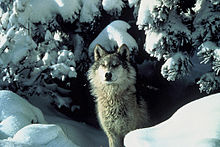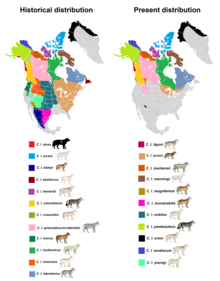Northern Rocky Mountain wolf
| Northern Rocky Mountain wolf | |
|---|---|

| |
| Scientific classification | |
| Domain: | Eukaryota |
| Kingdom: | Animalia |
| Phylum: | Chordata |
| Class: | Mammalia |
| Order: | Carnivora |
| Family: | Canidae |
| Genus: | Canis |
| Species: | C. lupus |
| Subspecies: | C. l. irremotus
|
| Trinomial name | |
| Canis lupus irremotus Goldman, 1937[2]
| |

| |
| Historical and present range of gray wolf subspecies in North America | |
The northern Rocky Mountain wolf (Canis lupus irremotus), also known as the northern Rocky Mountain timber wolf,
Physiology
Description
This subspecies generally weighs 70–150 pounds (32–68 kg) and stands at 26–32 inches, making it one of the largest subspecies of the gray wolf.[10] It is a lighter-colored animal that inhabits the Rocky Mountains with a coat including far more white and less black. In general, the subspecies favors lighter colors, with black mixing in among them.[2][11] Its population currently resides in western Montana, eastern Idaho, western Wyoming and southern Alberta.[12]
Dietary habits

The northern Rocky Mountain wolf preys primarily on the
When an individual or a pack is able to take down numerous prey, the amount a northern Rocky Mountain wolf eats daily will generally make up about 10–21% of its body mass, though there have been recorded instances of an individual eating up to 37% of its body mass. However, when prey is not as plentiful, northern Rocky Mountain wolves are able to survive for considerably long periods of time while eating only small amounts. Cannibalism, in times of severe food shortage, occurs, as a pack will kill and eat an injured or weak member of the group.[11]
History
Early recorded history of the northern Rocky Mountain wolf found it roaming primarily in the forests that would later become known as
As the American population began spreading west in the late 19th century,
Northern Rocky Mountain Wolf Recovery Plan
The Northern Rocky Mountain Wolf Recovery Plan was first approved in 1980, though it was then revised later on in 1987. The plan required a certain population of northern Rocky Mountain wolves to reside in the area inside and around Yellowstone, which included at least ten
In response to concerns about wolves being allowed to run free in the area, killing livestock without any allowed repercussions, the final draft of the plan, completed on November 22, 1994, outlined that ranchers were allowed to kill wolves if they were "caught in the act of killing livestock on private property".[5]
In three lawsuits combined as Wyoming Farm Bureau Federation v. Babbitt, opponents of reintroduction argued that the reintroduced wolves threatened wolves that might already inhabit the area, while supporters argued against the experimental designation and for fully protected status. District Court Judge William F. Downes ruled that the re-introduction violated section 10(j) of the Endangered Species Act; however, this ruling was overturned by the Tenth Circuit Court of Appeals.[5][6][19]
Policy changes for the ESA
In 2007, a
Environmental scientist Jeremy Bruskotter authored two papers in early 2009 stating that, if the memorandum is taken seriously, it could result in "an increased risk of extinction for some species." On the other hand, Robin Waples, a scientist at the National Oceanic and Atmospheric Administration's Northwest Fisheries Science Center, stated that "the memorandum by itself does not reduce protections".[20]
Since the memorandum was drafted, five rulings that relied heavily upon it were passed regarding endangered species, one of which was about the population of the northern Rocky Mountain wolf. The ruling decided that protection for the species was to be "sharply limited". However, in 2009, wildlife groups challenged the ruling.[20][21]
On January 21, 2009, President
U.S. District Judge Donald Molloy ruled in an appealed decision on August 6, 2010, that the northern Rocky Mountain wolf must either be "listed as an endangered species or removed from the list, but the protections for the same population can't be different for each state." This ruling came about from the challenged decision in 2009 by wildlife groups and would end many of the special regulations that individual states had held over the species. The Fish and Wildlife Service made a statement that endangered protections would remain for the entire species until Wyoming is able to bring the population of wolves within its borders into required standards. The populations for Idaho and Montana have already exceeded the requirements and, thus, previously had had no protections for the wolves in the states.[7]
On August 31, 2012, the US Fish and Wildlife Service announced that it would be removing endangered species protections from the northern Rocky Mountain wolf, as Wyoming has achieved the necessary populations to qualify with 328 wolves. Fish and Wildlife Service Director Dan Ashe called the renewal of the wolf subspecies to be a "major success story". Wyoming has also instituted its own "dual status" system that would protect the wolves inside Yellowstone park, but allow any wolves who leave the area to be shot on sight. Currently, 224 of the 328 wolves in Wyoming live outside of Yellowstone Park.[8]
In September, 2014, the US District Court for the District of Columbia vacated the delisting of the Northern Rocky Mountain wolf, which then reverted to its former status as a nonessential experimental population in all of Wyoming.[22]
References
- ^ "Canis lupus". explorer.natureserve.org.
Alberta: S4
- ^ JSTOR 1374306.
- OCLC 33339584.
- ^ Glover, A. (1942), Extinct and vanishing mammals of the western hemisphere, with the marine species of all the oceans, American Committee for International Wild Life Protection, pp. 205-206.
- ^ a b c Elizabeth Cowan Brown (2000). "The "wholly separate" truth: did the Yellowstone wolf reintroduction violate Section 10(J) of the Endangered Species Act?". Boston College Environmental Affairs Law Review. 27 (3). Boston College: 425–465. Archived from the original on 2010-12-13. Retrieved 2010-08-04.
- ^ a b Wyoming Farm Bureau Federation v. Babbitt, 97-8127 Patrick Fisher (United States Court of Appeals, Tenth Circuit January 13, 2000).
- ^ a b Matt Volz (August 6, 2010). "Wildlife advocates hail Rocky Mountain wolf ruling". Associated Press.
- ^ a b Patrik Jonsson (September 1, 2012). "Open season: Will rebounding Wyoming wolves thrive without US protection?". The Christian Science Monitor. Retrieved September 1, 2012.
- ^ a b c Nelson King (2007). "Wolves in Yellowstone: A Short History". Yellowstone Insider.
- ^ ISBN 978-0-520-21199-5.
- ^ "Northern Rocky Mountain wolf (Canis lupus irremotus)". 3 July 2016.
- ^ Mike Chrysler (October 4, 1998). "Wolf takes horse whisperer's path". The Tampa Tribune. p. 4.[permanent dead link]
- ^ T. R. Reid (August 31, 1989). "Humans now aid wolf they nearly eradicated". Schenectady Gazette.
- ^ "Wildlife official defends wolf plan". The Spokesman-Review. December 4, 1987. p. A10.
- Sun Journal. p. 23.
- ISBN 978-0-226-51696-7.
- ^ "Northern Rocky Mountain Wolf Recovery Plan" (PDF). United States Fish and Wildlife Service. 1987.
- ISBN 978-0-8166-3977-9.
- ^ .
- ^ a b "Obama freezes pending federal rules, wolves may benefit". Environment News Service. January 21, 2009.
- ^ "Western Gray Wolf Home Page: U.S. Fish and Wildlife Service". www.fws.gov. Archived from the original on 2006-12-06.
External links
- "Feds renewing efforts to delist wolves?" – Idaho Mountain Express Archived 2012-02-29 at the Wayback Machine
- "Are northern Rockies wolves on the decline?" – Idaho Mountain Express Archived 2014-03-23 at the Wayback Machine
- "Utah split on wolf protection status" – Standard Examiner Archived 2016-03-05 at the Wayback Machine
- Gray Wolves in the Northern Rocky Mountains U.S. Fish and Wildlife Service

